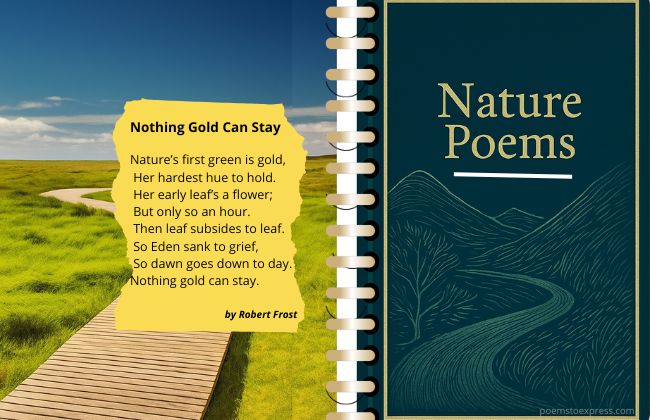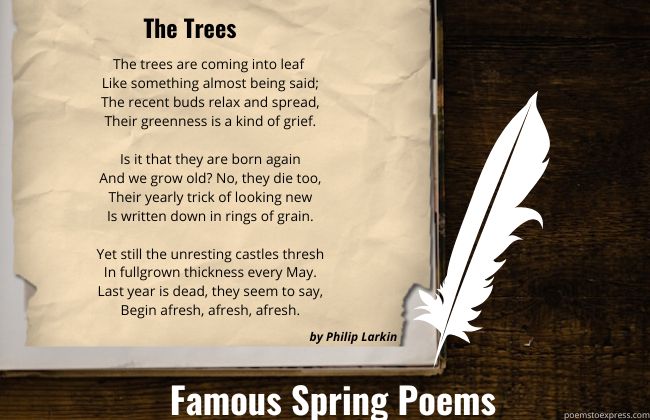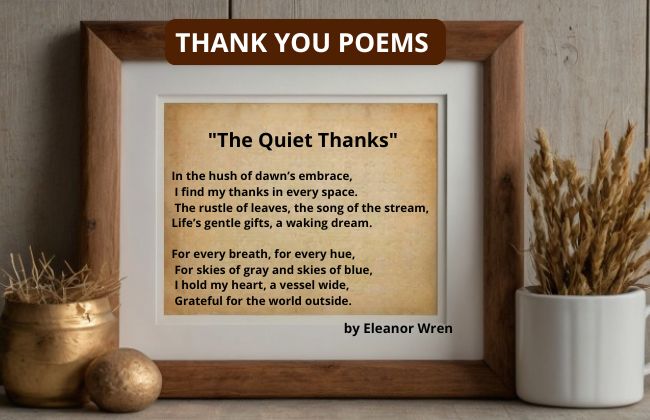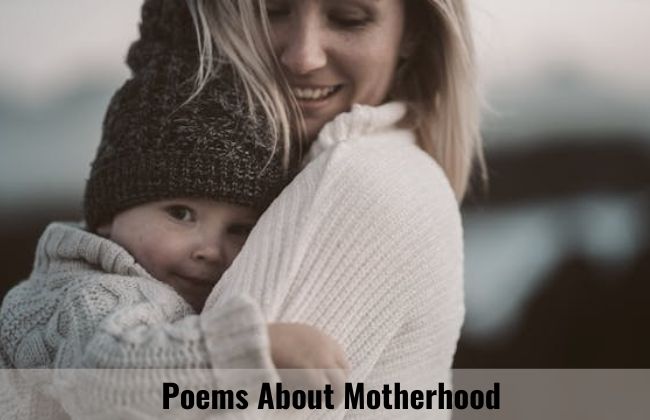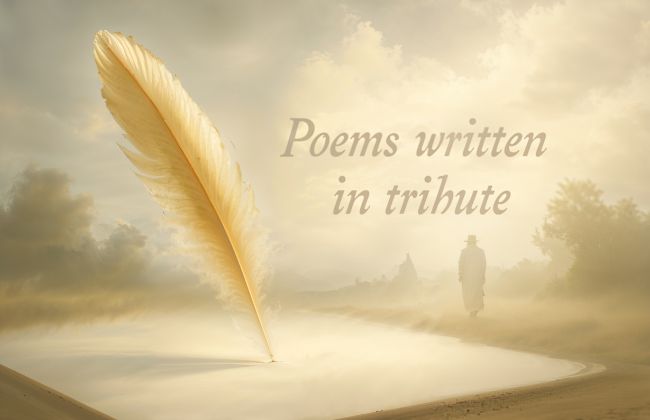Poetry has always been a powerful way to capture emotions, tell stories, and inspire the imagination. Among its many forms, free verse stands out for its boundless creativity.
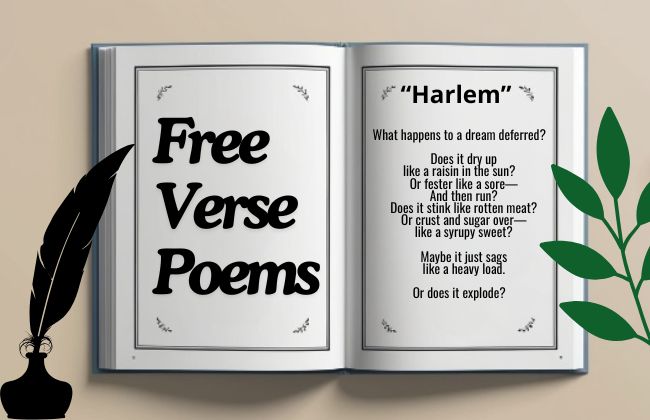
Unlike traditional poetry, free verse does not adhere to strict rules of rhyme or meter. Instead, it flows naturally, similar to everyday speech, granting poets the freedom to shape their work in unique and personal ways.
This style, which emerged strongly in the late 19th and early 20th centuries, has since inspired countless poetic creations.
Free verse invites us into a world where words can dance, pause, and speak at their own pace. From exploring the depths of human experience to painting powerful scenes with just a few lines, this style amplifies the poet’s voice in ways that other styles could not.
In this post, we present 10 examples of free verse poems, highlighting their creativity as a form of enduring and influential expression.
Table of Contents
- 1 1) “The Red Wheelbarrow” by William Carlos Williams
- 2 2) “The Love Song of J. Alfred Prufrock” by T.S. Eliot
- 3 3) “Howl” by Allen Ginsberg
- 4 4) “This Is Just to Say” by William Carlos Williams
- 5 5) “Song of Myself” by Walt Whitman
- 6 6) “The Waste Land” by T.S. Eliot
- 7 7) “Daddy” by Sylvia Plath
- 8 8) “Caged Bird” by Maya Angelou
- 9 9)“The Dying Lover” by Gustave Kahn
- 10 10) “Harlem(A Dream Deferred)” by Langston Hughes
- 11 Characteristics of Free Verse Poems
- 12 Historical Context
1) “The Red Wheelbarrow” by William Carlos Williams
Written in 1923, this poem’s structure defies traditional meter and rhyme schemes, favoring a stripped-down style that directs attention to the individual importance of each word and its placement.
The Red Wheelbarrow” thus exemplifies the imagist movement’s focus on the power of everyday objects and their potential to evoke profound insight. T
his approach has cemented the poem’s status within the American literary canon as an influential model of modern free verse.
so much depends
upon
a red wheel
barrow
glazed with rain
water
beside the white
chickens
2) “The Love Song of J. Alfred Prufrock” by T.S. Eliot
Created between 1910 and 1911, with its publication coming in 1915, the poem channels the modern human condition through its titular character, Prufrock.
Eliot’s free verse technique is on full display as he navigates through the introspections and musings of Prufrock without the constraints of traditional poetic meter.
The poem is an interior monologue, presenting Prufrock’s thoughts as fragmented and nonlinear, which reflects the complexity of modern social dynamics and self-awareness.
This style allows Eliot to break free from the patterns of rhyme and rhythm, thereby pushing the boundaries of what poetry can convey.
Let us go then, you and I,
When the evening is spread out against the sky
Like a patient etherized upon a table;
Let us go, through certain half-deserted streets,
The muttering retreats
Of restless nights in one-night cheap hotels
And sawdust restaurants with oyster-shells:
Streets that follow like a tedious argument
Of insidious intent… See full poem
3) “Howl” by Allen Ginsberg
The poem is characterized by its free verse style, utilizing long, breathless lines that capture a sense of spontaneity and raw emotion.
Ginsberg begins with the line, “I saw the best minds of my generation destroyed by madness, starving hysterical naked,” setting the stage for a work that addresses themes of alienation and societal disillusionment.
The structure of “Howl” is unconventional, foregoing traditional meter in favor of a rhythm influenced by jazz, religion, and personal experience. This literary choice reflects the poet’s intent to convey feelings of urgency and intensity.
I saw the best minds of my generation destroyed by
madness, starving hysterical naked,
dragging themselves through the negro streets at dawn
looking for an angry fix,
angelheaded hipsters burning for the ancient heavenly
connection to the starry dynamo in the machin-
ery of night,
who poverty and tatters and hollow-eyed and high sat
up smoking in the supernatural darkness of
cold-water flats floating across the tops of cities
contemplating jazz,.. See full poem
4) “This Is Just to Say” by William Carlos Williams
“This Is Just to Say” stands as a distinguished example of free verse poetry, penned by the American modernist poet William Carlos Williams in 1934.
The poem mimics the form of a brief apology note, left ostensibly by a husband for his wife upon eating plums that were stored in the icebox.
The structure of Williams’s poem is informal and devoid of a regular meter or rhyme scheme, characteristics that exemplify free verse. Employing simple, conversational language, Williams captures a moment of everyday life, lending the piece an intimate quality.
I have eaten
the plums
that were in
the icebox
and which
you were probably
saving
for breakfast
Forgive me
they were delicious
so sweet
and so cold.

5) “Song of Myself” by Walt Whitman
“Song of Myself” stands as Walt Whitman’s monumental piece of free verse poetry, encapsulating the core elements of the American Transcendentalist movement.
Spread across a vast 1,300 lines, it was initially published in the 1855 collection “Leaves of Grass.” Whitman’s work is distinguished by an absence of regular rhyme scheme or standard meter, which was an innovative departure from traditional poetic forms of his time.
The poem is characterized by a celebration of individuality and a profound connection to the collective human experience. Whitman conveys a deep immersion within nature and a broader, universal self that resonates beyond the personal.
I celebrate myself, and sing myself,
And what I assume you shall assume,
For every atom belonging to me as good belongs to you.
I loafe and invite my soul,
I lean and loafe at my ease observing a spear of summer grass.
My tongue, every atom of my blood, form’d from this soil, this air,
Born here of parents born here from parents the same, and their parents
the same,.. See full poem
6) “The Waste Land” by T.S. Eliot
Published in 1922, this poem is a landmark in modernist literature, presenting a profound and often disconcerting depiction of post-World War I disillusionment. Eliot utilizes fragmented narrative, diverse cultural references, and shifts in speaker and scene to convey the chaotic state of contemporary society.
Not constrained by traditional verse forms, “The Waste Land” employs a range of literary and linguistic techniques, from colloquial language to complex allusions.
Its lack of a consistent meter and rhyme scheme exemplifies the flexibility of free verse, challenging readers to find coherence within its eclectic structure.
April is the cruellest month, breeding
Lilacs out of the dead land, mixing
Memory and desire, stirring
Dull roots with spring rain.
Winter kept us warm, covering
Earth in forgetful snow, feeding
A little life with dried tubers… See full poem
7) “Daddy” by Sylvia Plath
Published posthumously in 1965 in the collection “Ariel,” the poem captures the complexities of the poet’s turbulent emotions towards her father, Otto Plath.
The poem extends to 16 quintains and uses vivid imagery and language to explore themes of loss, trauma, and the struggle for identity. It reflects Plath’s personal history, including her father’s early death and her fraught relationship with him.
Plath’s use of end and internal rhymes, despite the free verse form, creates a haunting musicality, making “Daddy” a powerful testament to her poetic genius and an influential piece in American literature.
You do not do, you do not do
Any more, black shoe
In which I have lived like a foot
For thirty years, poor and white,
Barely daring to breathe or Achoo… See full poem
8) “Caged Bird” by Maya Angelou
Crafted with no strict meter or rhyme scheme, the poem flows naturally, much like the speech patterns of everyday conversation.
Its structure bears the hallmark of Angelou’s conversational tone, which allows the verses to breathe and resonate with the thematic essence of freedom versus confinement.
Angelou utilizes the imagery of two birds – a free bird and a caged bird – as a metaphor for the dichotomy between freedom and oppression.
The poem, written in 1983, echoes the struggles of African American history, yet its themes are universal, speaking to anyone who has experienced confinement in a metaphorical or literal sense.
Un pájaro libre salta
En la espalda del viento
y flota río abajo
hasta que termine la corriente
y baja su ala
En los rayos del sol anaranjado
y se atreve a reclamar el cielo… See full poem
9)“The Dying Lover” by Gustave Kahn
In “The Dying Lover” by Gustave Kahn, free verse serves as an expressive vehicle to explore the emotional depth of love and mortality.
Kahn uses this form to reflect the ephemeral and often chaotic nature of life and human emotions.
By freeing himself from the constraints of meter and rhyme, the poet captures the uninterrupted flow of thought and feeling, allowing the language to naturally shape itself according to the emotional impulse.
The poem conveys a sense of urgency and fragility, highlighting the intensity of love in the shadow of impending death.
SO long as the child preferred to me such and such a
player of the flute or singer to the zither,
little I cared
that she loved such and such a player of the flute or
scratcher of the zither. By the cross-roads I have fallen struck, struck by the
thrust of a sword.
Whose? Player of flute or scratcher of zither? How long the night is to be so slow in dying.
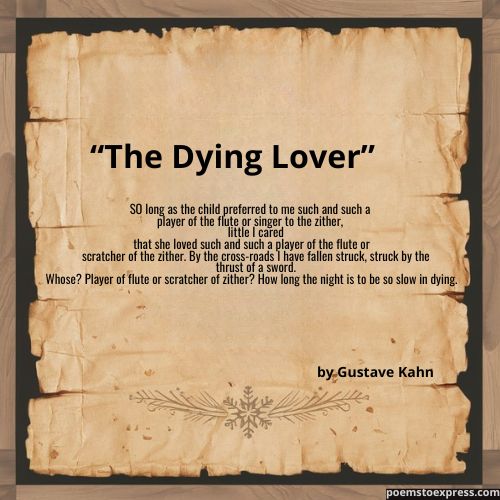
10) “Harlem(A Dream Deferred)” by Langston Hughes
“Harlem” by Langston Hughes uses free verse to deeply explore the corrosive effect of deferred dreams on the African American community.
Through rhetorical questions and powerful metaphors, Hughes probes what happens to an unrealized dream: does it dry up, rot, explode? These vivid images capture the frustration and accumulated despair.
The free verse allows Hughes a conversational flow that mirrors the introspective tone and urgency of the subject.
What happens to a dream deferred?
Does it dry up
like a raisin in the sun?
Or fester like a sore—
And then run?
Does it stink like rotten meat?
Or crust and sugar over—
like a syrupy sweet?
Maybe it just sags
like a heavy load.
Or does it explode?
Characteristics of Free Verse Poems
1. Lack of a Fixed Meter
Unlike traditional poetry that adheres to a specific meter (such as iambic pentameter), free verse poems do not follow a consistent metrical pattern.
This allows poets to create rhythms that mimic natural speech, giving the poem a more organic flow.
2. Absence of Rhyme Scheme
Free verse poems do not have a regular rhyme scheme. While some lines may rhyme, the overall structure does not rely on end rhymes. This freedom from rhyme allows poets to focus more on the content and meaning of their words.
3. Varied Line Lengths
In free verse poetry, line lengths can vary greatly. Poets may choose to write long, flowing lines or short, abrupt ones, depending on the effect they wish to achieve. This variability can create a unique visual and auditory experience for the reader.
4. Use of Enjambment
Enjambment, the continuation of a sentence without a pause beyond the end of a line, is commonly used in free verse poetry. This technique helps to maintain the poem’s flow and can create a sense of urgency or movement.
5. Emphasis on Imagery and Language
Free verse poems often place a strong emphasis on vivid imagery and evocative language.
Without the constraints of meter and rhyme, poets can experiment with word choice and syntax to create powerful, sensory experiences for the reader.
6. Flexibility in Structure
Free verse poems do not adhere to any specific structural rules. Poets have the freedom to arrange their lines and stanzas in any way they see fit, which can lead to innovative and unconventional forms.
7. Personal Expression
The flexibility of free verse poetry makes it an ideal form for personal expression. Poets can explore their thoughts, emotions, and experiences without being limited by traditional poetic conventions.
8. Use of Colloquial Language
Free verse poetry often incorporates colloquial or conversational language. This makes the poem more accessible and relatable to readers, as it mirrors the way people naturally speak.
Historical Context
Historically, free verse poetry emerged prominently in the late 19th and early 20th centuries. Poets such as Walt Whitman and William Carlos Williams were pivotal in its development. Whitman’s Leaves of Grass is a seminal work that celebrates the individual and the human experience through this form.
Williams, through poems like “The Red Wheelbarrow,” demonstrated how even the most ordinary moments could be captured poetically without traditional constraints.
The evolution of free verse is intimately connected to modernist movements that sought to challenge established norms and conventions, not only in literature but across the arts. As literary tastes and cultural values have continued to evolve, many poets have embraced free verse to convey complex emotions and ideas.
You might also like:

